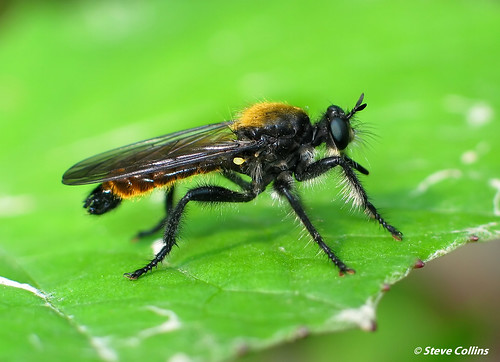bee-mimic robber flies
(Laphria sericea complex)
Overview • Description • Distribution • Taxonomy
Cedar Creek Ecosystem Science Reserve has both Laphria sericea (as Cryptocornutus sericea) and Laphria atkis (as Hirtochona atkis) on their Checklist of Minnesota Insects, but it has a record for only Laphria atkis. Adults are found from May to July in woodland edges and openings. The larvae live in the soil or in rotting wood, where they prey on the larvae of other insects. |
||
Description |
||
Adults are black, slender, and ½″ to 1″ (13 to 25 mm) in length. There is a dense mustache of long, stiff bristles (mystax) on the face immediately above the mouth. The mystax is black. On the lower part of the face there is a cluster of forward-directed bristles (a “beard”). The beard is whitish on the female, tawny on the male. On the female there are whitish hairs on the first segment (coxa) of each leg, downward curved whitish hairs on the face, and a tuft of whitish hairs below each wing base. On the male, these hairs are tawny. The upper side of the thorax and abdomen have yellowish-golden to brilliant red hair. On the male, at the rear margin of the sixth abdominal segment, there are two black, well-defined projections (forceps). The legs are stout and black. They are covered with long black hair mixed with white hair. The wings are clear and are tinted blackish. |
||
Distribution |
||||
|
Sources |
|||
| 10/8/2023 | ||||
Taxonomy |
|||
Order |
Diptera (Flies) | ||
Suborder |
Brachycera | ||
Infraorder |
Orthorrhapha | ||
Superfamily |
Asiloidea | ||
Family |
Asilidae (Robber Flies) | ||
Subfamily |
Laphriinae | ||
Tribe |
Laphriini | ||
Genus |
Laphria (bee-mimic robber flies) | ||
Subordinate Taxa |
|||
radiant laphria (Laphria atkis) silky laphria (Laphria sericea) undescribed species (Laphria sp.) |
|||
Synonyms |
|||
|
|||
Common Names |
|||
|
|||
Glossary
Coxa
The first (most proximal) segment of the legs of most arthropods, including all insects, spiders, and crustaceans, and most arachnids. It attaches the leg to the body and connects to the trochanter. Plural: coxae.
Mystax
On flies, especially in the family Asilidae, a patch of bristles or hairs (mustache) immediately above the mouth.
Visitor Photos |
|||||
Share your photo of this insect. |
|||||
| This button not working for you? Simply email us at info@MinnesotaSeasons.com. Attach one or more photos and, if you like, a caption. |
|||||
Alfredo Colon |
|||||
I enjoy taking pics of Robber Flies. This is a relatively big one and maybe a bee-mimicking one. |
 |
||||
 |
 |
||||
MinnesotaSeasons.com Photos |
|||||
|
|||||

Visitor Videos |
|||
Share your video of this insect. |
|||
| This button not working for you? Simply email us at info@MinnesotaSeasons.com. Attach a video, a YouTube link, or a cloud storage link. |
|||
Other Videos |
|||
| GOLDEN ROBBER FLY, Laphria sericea complex, looking around 3021164 ob Curtis |
|||
About
Aug 15, 2020 GOLDEN ROBBER FLY, Laphria sericea complex, looking around. McClaugher Springs FP, IL 6/8/2020 |
|||

Visitor Sightings |
|||||
Report a sighting of this insect. |
|||||
| This button not working for you? Simply email us at info@MinnesotaSeasons.com. Be sure to include a location. |
|||||
| Alfredo Colon 6/2/2021 |
Location: Woodbury, MN I enjoy taking pics of Robber Flies. This is a relatively big one and maybe a bee-mimicking one. |
||||
MinnesotaSeasons.com Sightings |
|||||
|
|||||

Created: 10/8/2023
Last Updated:



